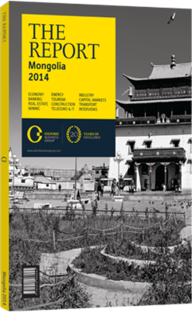Foundations for development: The government has begun investing heavily in infrastructure
Ranked 133rd of 148 in the World Economic Forum’s 2013 Global Competitiveness Index for overall infrastructure quality, Mongolia’s domestic and regional connectivity is hampered by poor-quality roads, inadequate power supply and the limited reach of its railways. From 2012 the government began investing heavily in infrastructure development, although most of this spending has been off-budget through the Development Bank of Mongolia (DBM). While DBM’s debt is accounted for in formal budgeting, its spending will not be for the next three years – exempting most infrastructure investment from the strictures of the Fiscal Stability Law’s (FSL) 2%-of-GDP budget deficit cap.
Off-Budget
Mongolia has long used off-budget mechanisms for funding infrastructure, particularly the build-transfer scheme whereby construction firms front costs in expectation of repayment from the budget on completion. Established in 2011 and funded through an initial $580m Eurobond in March 2012, DBM has significantly increased such unaccounted spending. Combined off-balance-sheet spending rose from 3% of the capital budget in 2008 to over 41% in 2012. Budgeted capital expenditure grew 35 times in a decade, reaching MNT2.49trn ($1.49bn) in 2013, though it is hindered by disbursement rates of below 80%. While under-execution has kept recent budget deficits within FSL limits, spending through DBM rose sharply in 2012, pushing off-budget spending to 8% of GDP in 2012 and 10% in 2013, and the total fiscal deficit to 10.9% of GDP and above 12%, respectively. Having spent 60% of the $580m Eurobond in 2012, DBM invested the remaining $232m in 2013 alongside proceeds of the $1.5bn sovereign Chinggis bond, floated in November 2012. By the end of 2013 Mongolia had disbursed $900m of the sovereign bond, according to World Bank estimates, leaving the remaining $600m for disbursement in 2014.
Projects
DBM’s spending has focused on executing key projects under the government’s four-year action plan to 2016 and on non-commercial ventures, a divergence from its mandate. Under the plan authorities aim to develop 5600 km of new railways, including an 1800-km line linking South Gobi mines to Chinese and Russian export markets, and a 270-km line connecting Tavan Tolgoi to China’s Inner Mongolia. The plan also includes a 990-km north-south highway connecting Russia to China, completed in November 2013, and an East-West Millennium Road that includes 2000 km of paved routes linking all provinces. The plan also calls for new power capacity through upgrades of existing plants and new generation through public-private partnerships.
On The Road
According to Resource Investment Capital, 40% of DBM’s 2013 spending went on road construction and maintenance, with disbursement accelerating from the start of construction season in April. This included $342m for 1400 km of inter-province paved roads and $200m for projects in Ulaanbaatar, according to the Ministry of Economic Development, the agency behind the Eurobond issues and overseeing DBM. Some 1800 km of roads were completed in 2013, adding to a total of 3000 km of paved roads as of the end of 2012, according to the prime minister. While investment has focused on new routes, existing infrastructure is in need of maintenance: 60% of Mongolia’s paved roads require rehabilitation, “with the ratio of capital repairs to new investment declining over the past five years,” according to the World Bank.
Some $200m has also been allocated for new rail projects under Mongolian Railways and $100m to finance a new Boeing 767-300 EK for MIAT, the national airline. Bond proceeds were also spent on housing, with $100m for the Government Housing Corporation and $142m on engineering infrastructure for Ulaanbaatar apartments. Another $50m was earmarked for feasibility studies and part of the government’s stake in the planned 450-MW Tavan Tolgoi power plant. The remainder of 2013 expenditure went on targeted sectors, including $57m to support upgrades in the cashmere industry, $45m for wool industries, $13.5m for textiles, $28m for milk factories, $17.4m to build winter greenhouses and some $50m for iron ore dressing factories.
You have reached the limit of premium articles you can view for free.
Choose from the options below to purchase print or digital editions of our Reports. You can also purchase a website subscription giving you unlimited access to all of our Reports online for 12 months.
If you have already purchased this Report or have a website subscription, please login to continue.

